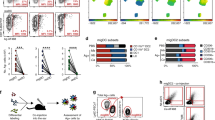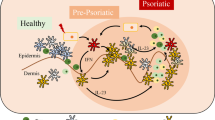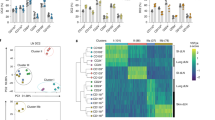Abstract
Langerhans cells (LCs) are the only dendritic cells of the epidermis and constitute the first immunological barrier against pathogens and environmental insults. The factors regulating LC homeostasis remain elusive and the direct circulating LC precursor has not yet been identified in vivo. Here we report an absence of LCs in mice deficient in the receptor for colony-stimulating factor 1 (CSF-1) in steady-state conditions. Using bone marrow chimeric mice, we have established that CSF-1 receptor–deficient hematopoietic precursors failed to reconstitute the LC pool in inflamed skin. Furthermore, monocytes with high expression of the monocyte marker Gr-1 (also called Ly-6c/G) were specifically recruited to the inflamed skin, proliferated locally and differentiated into LCs. These results identify Gr-1hi monocytes as the direct precursors for LCs in vivo and establish the importance of the CSF-1 receptor in this process.
This is a preview of subscription content, access via your institution
Access options
Subscribe to this journal
Receive 12 print issues and online access
$209.00 per year
only $17.42 per issue
Buy this article
- Purchase on Springer Link
- Instant access to full article PDF
Prices may be subject to local taxes which are calculated during checkout






Similar content being viewed by others

References
Hemmi, H. et al. Skin antigens in the steady state are trafficked to regional lymph nodes by transforming growth factor-β1-dependent cells. Int. Immunol. 13, 695–704 (2001).
Kripke, M.L., Munn, C.G., Jeevan, A., Tang, J.M. & Bucana, C. Evidence that cutaneous antigen-presenting cells migrate to regional lymph nodes during contact sensitization. J. Immunol. 145, 2833–2838 (1990).
Schuler, G. & Steinman, R.M. Murine epidermal Langerhans cells mature into potent immunostimulatory dendritic cells in vitro. J. Exp. Med. 161, 526–546 (1985).
Tang, H.L. & Cyster, J.G. Chemokine up-regulation and activated T cell attraction by maturing dendritic cells. Science 284, 819–822 (1999).
Mayerova, D., Parke, E.A., Bursch, L.S., Odumade, O.A. & Hogquist, K.A. Langerhans cells activate naive self-antigen-specific CD8 T cells in the steady state. Immunity 21, 391–400 (2004).
Allan, R.S. et al. Epidermal viral immunity induced by CD8α+ dendritic cells but not by Langerhans cells. Science 301, 1925–1928 (2003).
Kissenpfennig, A. et al. Dynamics and function of Langerhans cells in vivo: dermal dendritic cells colonize lymph node areas distinct from slower migrating Langerhans cells. Immunity 22, 643–654 (2005).
Bennett, C.L. et al. Inducible ablation of mouse Langerhans cells diminishes but fails to abrogate contact hypersensitivity. J. Cell Biol. 169, 569–576 (2005).
Merad, M. et al. Langerhans cells renew in the skin throughout life under steady-state conditions. Nat. Immunol. 3, 1135–1141 (2002).
Witmer-Pack, M.D. et al. Identification of macrophages and dendritic cells in the osteopetrotic (op/op) mouse. J. Cell Sci. 104, 1021–1029 (1993).
Takahashi, K., Naito, M. & Shultz, L.D. Differentiation of epidermal Langerhans cells in macrophage colony-stimulating-factor-deficient mice homozygous for the osteopetrosis (op) mutation. J. Invest. Dermatol. 99, 46S–47S (1992).
Wiktor-Jedrzejczak, W.W., Ahmed, A., Szczylik, C. & Skelly, R.R. Hematological characterization of congenital osteopetrosis in op/op mouse. Possible mechanism for abnormal macrophage differentiation. J. Exp. Med. 156, 1516–1527 (1982).
Wiktor-Jedrzejczak, W. & Gordon, S. Cytokine regulation of the macrophage (MΦ) system studied using the colony stimulating factor-1-deficient op/op mouse. Physiol. Rev. 76, 927–947 (1996).
del Hoyo, G.M. et al. Characterization of a common precursor population for dendritic cells. Nature 415, 1043–1047 (2002).
Caux, C. et al. CD34+ hematopoietic progenitors from human cord blood differentiate along two independent dendritic cell pathways in response to GM-CSF+TNF-α. J. Exp. Med. 184, 695–706 (1996).
Ito, T. et al. A CD1a+/CD11c+ subset of human blood dendritic cells is a direct precursor of Langerhans cells. J. Immunol. 163, 1409–1419 (1999).
Geissmann, F. et al. Transforming growth factor β1, in the presence of granulocyte/macrophage colony-stimulating factor and interleukin 4, induces differentiation of human peripheral blood monocytes into dendritic Langerhans cells. J. Exp. Med. 187, 961–966 (1998).
Larregina, A.T. et al. Dermal-resident CD14+ cells differentiate into Langerhans cells. Nat. Immunol. 2, 1151–1158 (2001).
Borkowski, T.A., Letterio, J.J., Farr, A.G. & Udey, M.C. A role for endogenous transforming growth factor β1 in Langerhans cell biology: the skin of transforming growth factor β1 null mice is devoid of epidermal Langerhans cells. J. Exp. Med. 184, 2417–2422 (1996).
Dai, X.M. et al. Targeted disruption of the mouse colony-stimulating factor 1 receptor gene results in osteopetrosis, mononuclear phagocyte deficiency, increased primitive progenitor cell frequencies, and reproductive defects. Blood 99, 111–120 (2002).
Cecchini, M.G. et al. Role of colony stimulating factor-1 in the establishment and regulation of tissue macrophages during postnatal development of the mouse. Development 120, 1357–1372 (1994).
Pixley, F.J. & Stanley, E.R. CSF-1 regulation of the wandering macrophage: complexity in action. Trends Cell Biol. 14, 628–638 (2004).
Byrne, P.V., Guilbert, L.J. & Stanley, E.R. Distribution of cells bearing receptors for a colony-stimulating factor (CSF-1) in murine tissues. J. Cell Biol. 91, 848–853 (1981).
Qu, C. et al. Role of CCR8 and other chemokine pathways in the migration of monocyte-derived dendritic cells to lymph nodes. J. Exp. Med. 200, 1231–1241 (2004).
Sunderkotter, C. et al. Subpopulations of mouse blood monocytes differ in maturation stage and inflammatory response. J. Immunol. 172, 4410–4417 (2004).
Dai, X.M., Zong, X.H., Akhter, M.P. & Stanley, E.R. Osteoclast deficiency results in disorganized matrix, reduced mineralization, and abnormal osteoblast behavior in developing bone. J. Bone Miner. Res. 19, 1441–1451 (2004).
Geissmann, F., Jung, S. & Littman, D.R. Blood monocytes consist of two principal subsets with distinct migratory properties. Immunity 19, 71–82 (2003).
Passlick, B., Flieger, D. & Ziegler-Heitbrock, H.W. Identification and characterization of a novel monocyte subpopulation in human peripheral blood. Blood 74, 2527–2534 (1989).
Randolph, G.J., Sanchez-Schmitz, G., Liebman, R.M. & Schakel, K. The CD16+ (FcγRIII+) subset of human monocytes preferentially becomes migratory dendritic cells in a model tissue setting. J. Exp. Med. 196, 517–527 (2002).
Tacke, F. et al. Immature monocytes acquire antigens from other cells in the bone marrow and present them to T cells after maturing in the periphery. (in the press).
Merad, M. et al. Depletion of host Langerhans cells before transplantation of donor alloreactive T cells prevents skin graft-versus-host disease. Nat. Med. 10, 510–517 (2004).
Bruno, L., Seidl, T. & Lanzavecchia, A. Mouse pre-immunocytes as non-proliferating multipotent precursors of macrophages, interferon-producing cells, CD8α+ and CD8α− dendritic cells. Eur. J. Immunol. 31, 3403–3412 (2001).
Schaerli, P., Willimann, K., Ebert, L.M., Walz, A. & Moser, B. Cutaneous CXCL14 targets blood precursors to epidermal niches for Langerhans cell differentiation. Immunity 23, 331–342 (2005).
Ryan, G.R. et al. Rescue of the colony-stimulating factor 1 (CSF-1)-nullizygous mouse (Csf1op/Csf1op) phenotype with a CSF-1 transgene and identification of sites of local CSF-1 synthesis. Blood 98, 74–84 (2001).
Roth, P. & Stanley, E.R. The biology of CSF-1 and its receptor. Curr. Top. Microbiol. Immunol. 181, 141–167 (1992).
Hume, D.A. & Favot, P. Is the osteopetrotic (op/op mutant) mouse completely deficient in expression of macrophage colony-stimulating factor? J. Interferon Cytokine Res. 15, 279–284 (1995).
Mende, I., Karsunky, H., Weissman, I.L., Engleman, E.G. & Merad, M. Flk2+ myeloid progenitors are the main source of Langerhans cells. Blood (2005).
Hannum, C. et al. Ligand for FLT3/FLK2 receptor tyrosine kinase regulates growth of haematopoietic stem cells and is encoded by variant RNAs. Nature 368, 643–648 (1994).
Hume, D.A., Pavli, P., Donahue, R.E. & Fidler, I.J. The effect of human recombinant macrophage colony-stimulating factor (CSF-1) on the murine mononuclear phagocyte system in vivo. J. Immunol. 141, 3405–3409 (1988).
Tushinski, R.J. et al. Survival of mononuclear phagocytes depends on a lineage-specific growth factor that the differentiated cells selectively destroy. Cell 28, 71–81 (1982).
Metcalf, D. The granulocyte-macrophage colony-stimulating factors. Science 229, 16–22 (1985).
Korn, A.P., Henkelman, R.M., Ottensmeyer, F.P. & Till, J.E. Investigations of a stochastic model of haemopoiesis. Exp. Hematol. 1, 362–375 (1973).
Nakahata, T., Gross, A.J. & Ogawa, M. A stochastic model of self-renewal and commitment to differentiation of the primitive hemopoietic stem cells in culture. J. Cell. Physiol. 113, 455–458 (1982).
Lagasse, E. & Weissman, I.L. Enforced expression of Bcl-2 in monocytes rescues macrophages and partially reverses osteopetrosis in op/op mice. Cell 89, 1021–1031 (1997).
Romani, N., Schuler, G. & Fritsch, P. Ontogeny of Ia-positive and Thy-1-positive leukocytes of murine epidermis. J. Invest. Dermatol. 86, 129–133 (1986).
Elbe, A. et al. Maturational steps of bone marrow-derived dendritic murine epidermal cells. Phenotypic and functional studies on Langerhans cells and Thy-1+ dendritic epidermal cells in the perinatal period. J. Immunol. 143, 2431–2438 (1989).
Tripp, C.H. et al. Ontogeny of Langerin/CD207 expression in the epidermis of mice. J. Invest. Dermatol. 122, 670–672 (2004).
Beverley, P.C., Egeler, R.M., Arceci, R.J. & Pritchard, J. The Nikolas Symposia and histiocytosis. Nat. Rev. Cancer 5, 488–494 (2005).
Rolland, A. et al. Increased blood myeloid dendritic cells and dendritic cell-poietins in Langerhans cell histiocytosis. J. Immunol. 174, 3067–3071 (2005).
Banchereau, J. et al. Immune and clinical responses in patients with metastatic melanoma to CD34+ progenitor-derived dendritic cell vaccine. Cancer Res. 61, 6451–6458 (2001).
Boring, L. et al. Impaired monocyte migration and reduced type 1 (Th1) cytokine responses in C–C chemokine receptor 2 knockout mice. J. Clin. Invest. 100, 2552–2561 (1997).
Cook, D.N. et al. CCR6 mediates dendritic cell localization, lymphocyte homeostasis, and immune responses in mucosal tissue. Immunity 12, 495–503 (2000).
Van Rooijen, N. & Sanders, A. Liposome mediated depletion of macrophages: mechanism of action, preparation of liposomes and applications. J. Immunol. Methods 174, 83–93 (1994).
Acknowledgements
Supported by the Association Francaise Contre le Cancer (F.G.), the German Research Foundation (F.T.), the National Institutes of Health (AI49653 to G.J.R., and CA32551 and CA26504 to E.R.S.), the American Society of Hematology (X.-M.D.) and the Leukemia and Lymphoma Society (X.-M.D.).
Author information
Authors and Affiliations
Corresponding author
Ethics declarations
Competing interests
The authors declare no competing financial interests.
Supplementary information
Supplementary Fig. 1
Experimental design. (PDF 149 kb)
Rights and permissions
About this article
Cite this article
Ginhoux, F., Tacke, F., Angeli, V. et al. Langerhans cells arise from monocytes in vivo. Nat Immunol 7, 265–273 (2006). https://doi.org/10.1038/ni1307
Received:
Accepted:
Published:
Issue Date:
DOI: https://doi.org/10.1038/ni1307
This article is cited by
-
STR typing of skin swabs from individuals after an allogeneic hematopoietic stem cell transplantation
International Journal of Legal Medicine (2023)
-
Signaling pathways, microenvironment, and targeted treatments in Langerhans cell histiocytosis
Cell Communication and Signaling (2022)
-
M2-polarized macrophages mediate wound healing by regulating connective tissue growth factor via AKT, ERK1/2, and STAT3 signaling pathways
Molecular Biology Reports (2021)
-
In situ neutrophil efferocytosis shapes T cell immunity to influenza infection
Nature Immunology (2020)
-
Niche rather than origin dysregulates mucosal Langerhans cells development in aged mice
Mucosal Immunology (2020)


